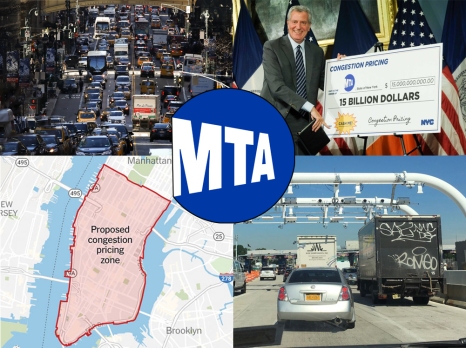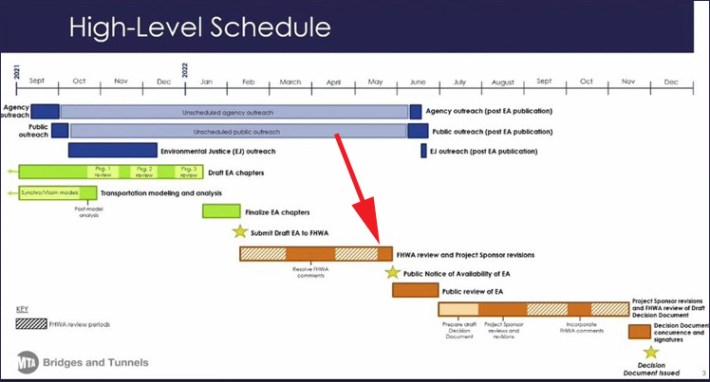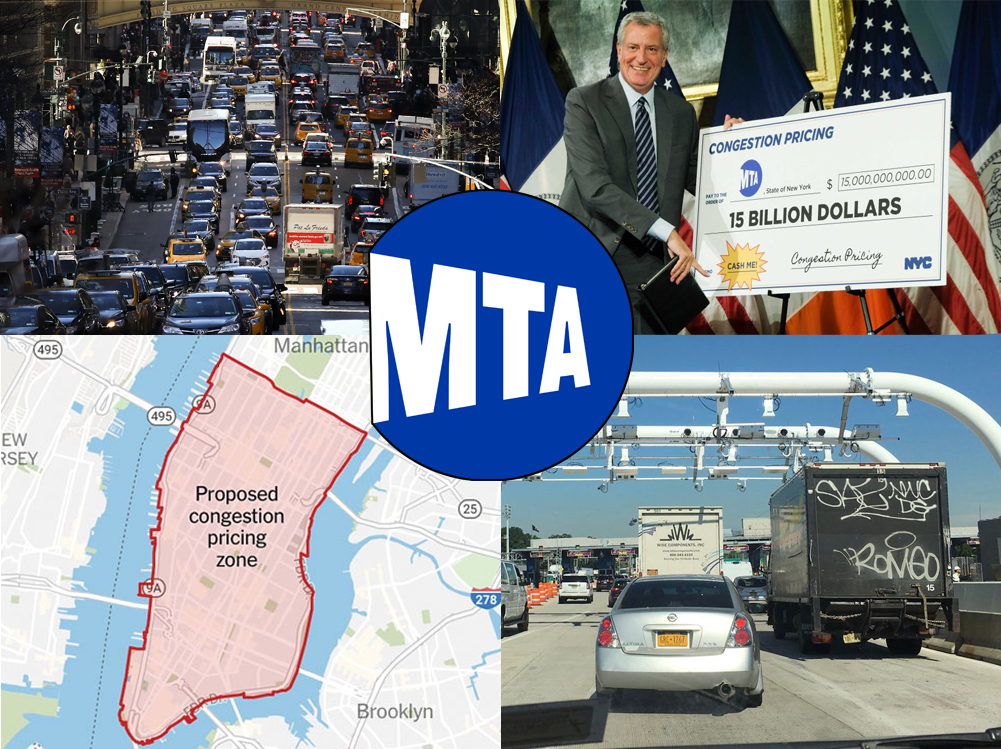
That’s one roadblock lifted.
MTA Chairman and CEO Janno Lieber announced on Wednesday that the agency had finally answered the hundreds of technical questions that the Federal Highway Administration asked on the MTA’s draft environmental assessment for congestion pricing, a bump in the road covered by everyone from the lowly worms at Streetsblog to the New York Times’s aging whiz kid Ezra Klein.
“We have been able to address virtually all of the questions and data requests thrown at us by our federal partners,” Lieber announced at this month’s MTA Board meeting. “And last week — big milestone — we resubmitted the draft environmental assessment.”
Milestone, yes, but delay, certainly. Initially, the MTA was expecting to release the draft environmental assessment to the public a few weeks ago, but Lieber said in May that it was delayed because the FHWA asked 425 technical questions on how the toll would impact the city and zone that went as far south as the Philadephia suburbs (which Lieber expressed frustration at). But on Wednesday, the MTA boss was back in high spirits about congestion pricing’s timeline.
“Everybody knows that that process was taking some time, but it’s back at the Federal Highway Administration,” he said. “They have to review it, but once that review is complete, we will be putting it out to the public for public review and for additional outreach. In the end, we have stanched the loss of time on this congestion pricing process and we’re hoping that we lost no more than four to six weeks as a result of some of the difficulties in answering all those data requests in question,” he said.

The original high-level schedule for congestion pricing (above) places the FHWA’s final decision at the end of November or beginning of December. Especially if the MTA and FHWA can make up time in a different piece of the schedule, the loss of about a month could still allow the federal government to issue a finding of no significant impact in the congestion pricing environmental review before the end of 2022, which would clear the MTA to be able to implement the toll in the back half of 2023.
Making even incremental progress on the congestion pricing environmental assessment is critical for the MTA and its historic $55-billion 2020-2024 capital plan. Lieber himself has said that without congestion pricing, huge chunks of the planned work on things like accessibility upgrades, upgrade subway signals and buying new train cars and electric buses simply won’t be able to get funding without the $1 billion in congestion pricing revenue that’s bonded out to $15 billion in capital plan spending.
The MTA boss’ comments on just how bad the MTA and the city needs congestion pricing was backed up by Albany watchdogs Reinvent Albany, which on Wednesday showed that the current capital plan is being funded at a slower pace than the two previous plans before it. With just 7 percent of its total funding having come in through the first 29 months of the capital plan, Reinvent Albany warned that the MTA is at risk of not committing all of the capital plan spending it aimed to spend by 2024, especially because congestion pricing is supposed to cover a whopping 27 percent of the entire five-year plan.
While agreeing with the idea that the MTA did need congestion pricing, Lieber disputed the report’s conclusion that the capital plan was at a high risk of not being completed, since city and state money is starting to flow into the capital plan again, such as an upcoming $700 million bond issuance backed by city sales tax money.
“We have no cash-flow issues on the capital program. Any apples-to-apples comparison of the expenditures in the capital program needs to take into account the fact that we had a 15- to 18-month delay in our ability to award the [2020-2024] projects because of Covid,” he said. “We were holding off because we needed to know what we were getting from Washington, so there was a significant delay to the award projects. Therefore the cashflow is delayed and the analysis should reflect that.”
The congestion pricing environmental assessment progress also means that the MTA is one step closer to convening the Traffic Mobility Review Board, the panel that’s supposed to recommend the actual prices for the congestion tolls and deal with the headache of every single politically connected constituency demanding an exemption to said toll. Mayor Adams waded into the exemption debate — again! — on Wednesday, with a reiteration of his previous asks to exempt low-income New Yorkers and people going to chemotherapy appointments in Manhattan, the same exemption suggestions he made in 2021 while running for mayor.
“Those who are low-income New Yorkers that must use vehicles, let’s say if you have to go to chemo treatment at a certain hospital, we should take that into consideration,” he said. “It shouldn’t be just a blanket of we’re not exempting anyone, and it can’t be just city vehicles. I’m open to real conversation, and hear[ing] from those who must use vehicles.”
For his part, Lieber reminded the mayor and the world that every exemption will just mean everyone else on the road paying a little bit more for the traffic toll.
“We have to let the TMRB do its work balancing the most important point which is that it has to make sure, according to legislation, that there’s enough revenue for the MTA so that we get are able to bond to get $15 billion into the capital program. So if there were exemptions or discounts, there will be a higher total because it all has to equal enough revenue to turn into $15 billion in bonds,” he said.
Meanwhile, down in Washington, U.S. Department of Transportation Secretary Pete Buttigieg held a conference call with reporters, yet did not take off-topic questions. So Streetsblog asked the agency:
- Why did the USDOT raise so many questions on the MTA’s environmental assessment?
- Many New Yorkers believe the federal authorities raised so many questions simply to slow down the process. How does the USDOT respond to that charge?
- How quickly will the USDOT get this back to the MTA on its answers to the technical questions?
- Will you make the USDOT’s questions public as you have declined to do thus far? We believe that the technical questions are a public document.
An agency spokesperson issued the following statement, which answered none of the specific questions above:
FHWA views congestion pricing for New York City as an important and potentially precedent-setting project designed to reduce congestion, improve air quality, create a sustainable capital funding source for transit, increase transit ridership and improve transit services for low-income residents. FHWA has been both collaborating with and assisting MTA, the City of New York and New York State Department of Transportation throughout the National Environmental Policy Act process to arrive at a timely and informed NEPA determination on this important project.
FHWA has met weekly with the MTA and other New York stakeholders to work through and resolve comments on the Draft Environmental Assessment submitted earlier this year. Through collaborative revision, we have reached a milestone in the process with MTA providing FHWA with a resubmission that has addressed critical comments. FHWA is already reviewing that resubmission and looks toward working with MTA to completing the environmental assessment so that it can be released for the final round of public meetings and public comment.
— with Gersh Kuntzman






